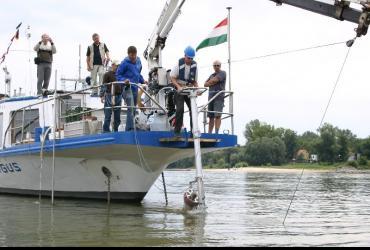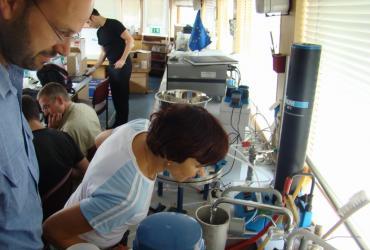The “air-lift” sediment sampler, the most visibly prominent feature of the Argus ship protruding from its bow, was a big success. Used for the first time on the Danube, it could take samples at depths of up to 11 m from substrates including sand, gravel and stone. Before joining the JDS2, Romanian biologist Gabriel Chiriac had relied on the older methods of “kick-and-sweep” and dredging. “But we couldn’t reach big depths before air-lifting,” he said.
An excellent example of the broader scientific ripples being sent out by the JDS2 was the “core sediment sampling” done near Kostolac, Serbia. This is a tricky and expensive technique where cores, once emoved, are sliced into five cm portions and analyzed for pollutants. A team of University of Vienna scientists led by Professor Thilo Hoffman, and with Serbian PhD student Vesna Micic who joined the JDS2 team, is using the technique and resulting data as part of their studies of “endocrine disrupters”, organic compounds which can significantly impact the hormones of animals such as humans, fish and snails. “JDS1 found alarming concentrations in Danube sediment,” says Hoffman. “We needed the JDS2 to better understand where they are, why they accumulate and how they behave. We would never have had samples without the JDS2.”
One of the scientific institutions most interested in the results of the JDS2 is the European Commission’s Joint Research Centre (JRC) based in Ispra, Italy. One of its key goals is to provide support for the development of EU policies and regulations. Until now, the EC has had legal limits imposed on 33 “Priority Chemical Substances” found in water. Some chemicals, some highly toxic, are very “sticky” and tend to attach to particles and other solid objects. Some of this solid matter is found at the bottom of the river in “sediment”. However, many chemicals also adhere to particles “suspended” in the water, which means that they are transported downstream by river currents.
Understanding which chemicals are trapped by suspended particulate matter or which are at the river bottom could lead to new legislation and environmental quality standards for EU Member States. Unsurprisingly, the idea is extremely controversial. The work being done through the JDS2 was a pilot project and the largest experiment of its kind related to this EU assessment. Basically, river water was continuously pumped from the river to a centrifuge on-board the Argus ship which separated the suspended particles from the water. The collected suspended particulate matter and the water from which the particles were removed then underwent simultaneous chemical testing.



















